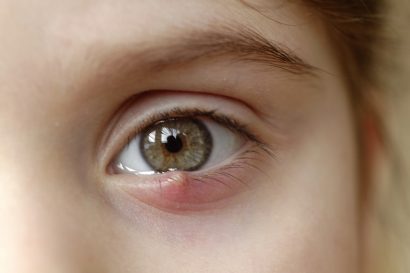I Spy a Stye in Your Eye
Written by Dr. David Evans Last modified on August 6, 2018
What’s that small, red, pimple-like bump on your eyelid that’s causing so much discomfort? It’s probably a stye (sometimes referred to as a sty or hordeolum). Besides being difficult to say 5 times quickly, an eye stye is a type of localized infection that can occur along the base of your eyelashes or underneath your eyelid.
Styes that form along the base of the eyelashes are called external styes. They typically occur as a result of an infected eyelash hair follicle and look like the type of pimple that occurs when your pores are clogged with dirt and oil.

Styes that form inside the eyelid are called internal styes. Similar to external styes, they are caused by an infection of an oil-producing gland behind the eyelid rather than an eyelash hair follicle. Internal styes result in generalized swelling of the eyelid rather than forming a pimple-like bump.
Stye Symptoms
As a stye develops, you might begin to experience pain and tenderness around the affected area. This can be accompanied by redness and swelling (which may be localized or affect the entire eyelid). Eyelid swelling can cause additional issues, including itchiness, light sensitivity, eye discharge and eyelid dryness.
Styes are contagious, so it’s important that you avoid sharing towels, washcloths, pillows, sheets or blankets with anyone during an active infection. This is similar to the management of another eye infection commonly referred to as pink eye. (Check out our 5 tips on stopping the spread of pink eye.)
Although many people “pop” pimples on their skin to get rid of them, you should absolutely not do anything of the sort with a stye. Avoid contact altogether and let it heal naturally. Or, contact your eye doctor for treatment. If you do come into contact with a stye, wash your hands immediately.
What Causes Styes?
The bacteria most commonly causing the infection is staphylococcal (staph), which is typically found in the nose and can be transferred when you rub it, then rub your eyes. Although staph is the most common bacteria associated with styes, it is not the only one.
Should You Be Concerned?
Styes are relatively common and not necessarily a cause for concern. They typically heal on their own over the course of a few days (similar to pimples). That said, you should consult with an eye doctor if your stye is causing significant pain or discomfort, if you experience any changes to vision, or if it doesn’t go away within a week or two.
Help the Heal
Styes typically go away on their own, but there are a number of things you can do to facilitate the healing process.
One of the most important ways to help is by keeping your eyes clean. Rinse your eyelids with warm water and dab them dry using a soft washcloth or disposable makeup remover. (If you use a washcloth, remember to disinfect it.)
Don’t wear makeup and avoid soaps and shampoos that can further irritate your eyes or cause you to rub them. Once a stye develops, you are encouraged to treat it with a warm compress several times a day for a period of 10-to-15 minutes. This warm compress can help alleviate the itching and generalized discomfort, in addition to helping speed up the healing process.

Dr. Brian Brazzo
If your stye doesn’t go away, you may need an eye doctor to drain it, or treat it with antibiotic cream or a steroid injection. Dr. Brian Brazzo is a board-certified ophthalmologist and fellowship-trained plastic surgeon specializing in ophthalmic plastic, reconstructive and cosmetic surgery who practices in New York City with Pamel Vision and Laser Group.
When it comes to treating Styes, Dr. Brazzo notes “my first choice of treatment for nearly all stye cases I see is an injection of steroid medication.” Dr. Brazzo has not done a formal study on the effectiveness of steroids as a stye treatment, but after treating thousands of lesions, he estimates “that approximately 70 – 80% improved significantly within three-to-four days following injection.”
It’s a Bump, but it’s Not a Stye
An important caveat to note is that not all bumps that form on the eyelid are styes. Chalazia is often mistaken for a stye because it causes a bump on the eyelid resulting from blocked oil glands. Although it initially shares some of the same symptoms as a stye, it can develop into a small, painless, hard lump (chalazion) and linger for weeks or months.
If you have a lump on your eye or any other type of irritation or swelling that you are concerned about, schedule an appointment with an eye doctor for a thorough exam.
